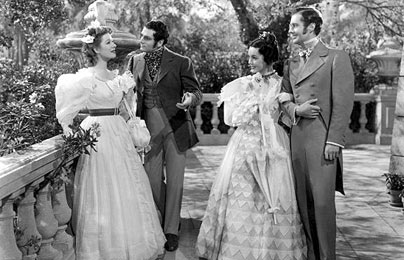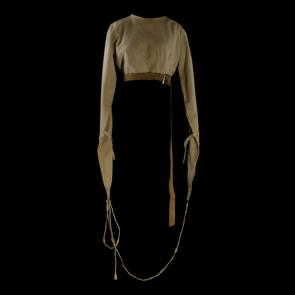Restraint. It’s such a polite word. What does it mean to you? Genteel Victorian ladies in romance novels? Bondage in Fifty Shades of Grey? Artistic photographs from the Held exhibition? Or perhaps the word conjures up the grotesque inhumanity of the face-down restraint and forced medication that take place on psychiatric wards up and down the country every day of the week and which are the subject of mental heath charity Mind’s new campaign. (See below for links to Mind’s campaign, press coverage, commentary and resources.)
The word restraint is reminiscent of Victorian novels of manners such as Jane Austen’s Pride and Prejudice. Of elegant ladies and gentlemen, like the renowned actors pictured above, exercising self restraint to stay within the confines of the social norms of the day. Rather than going “at it like knives on battered settees” (to quote a humorous song), characters manoevre to form genteel and restrained attachments.
Restraint also has connotations of the erotic kind. That’s especially so since the Fifty Shades mommy porn phenomenon brought bondage to the mainstream. By now there’s a Fifty Shades of Grey official pleasure collection, which includes a bed restraint kit, “approved by author” E L James. There’s even a parody novel incorporating Pride and Prejudice, called Fifty Shades of Mr Darcy.
Some think of restraint in mental health settings as an interesting topic for art, fashion, photography and academic discussion. Photographer and fashion designer Jane Fradgley’s exhibition Held (see here and here) has a related symposium on restraint. Her photographs are inspired by the historical collection of “strong clothing” at the Bethlem Royal Hospital Archive & Museum and explore her impressions of restraining garments as facilitating dignity, comfort and protection. That’s straight jackets..
When I hear the word restraint, however, the first thing that springs to mind isn’t Victorian ladies, saucy pleasures or artistic photos. It’s the brutal reality I’ve experienced of being pinned face down by teams of six as a vulnerable psychiatric inpatient. It was done to me repeatedly, to administer medication. There was never a justification. It was done to me without warning. It was done to me without explanation. It was done to me without any shred of compassion. It was done to me routinely, on a schedule I was not told about. It was done to me as a first resort.
It’s too traumatic for me to write about again. However, if you want to know more, read this blog, Treated Like an Animal, where I describe one incidence of face down restraint step by step.
Late yesterday, when I checked twitter, my feed was filled with references to restraint. It was not good for me: here‘s my reaction. Hours later, after the flashbacks and tears had subsided, I was still sick to my stomach, heart pumping, unable to sleep.
Why had there been so many tweets on my feed about restraint? Because mental health charity Mind was publicising the launch of its campaign around the use of physical restraint in mental health care using the hashtag #crisiscare. As Mind says:
“When people’s lives come crashing down in a crisis, they need help not harm. We’re calling for national standards on the use of restraint, accredited training and an end to face down restraint. Excellent crisis care exists. It can save lives. And that’s why we need it available for everyone.”
It’s an important campaign, and one which must succeed so that the harms like those that were inflicted on me when I was at my most fragile aren’t allowed to be imposed on others in the same way. Here’s my personal experience of the harm done by physical restraint in a mental health setting:
- It destroyed any chance of developing a therapeutic relationship with ward staff. Staff became my jailers and tormenters, wielding arbitrary power, casually chatting over me to each other as they did their business. All I was interested in while on ward was discharge, not healing: get out, get away from staff and make sure they never came after me again. Fear of psychiatric staff affects me to this day.
- Mentally I was pushed to a place I would never have gone to had I received care rather than violence. At my most vulnerable, I was brutalised. Like smashing down a sledge hammer again and again on a tender broken wrist instead of enveloping it in a protective plaster cast, these restraints made me much, much worse than I ever needed to be.
- Each time it was done to me, I was reduced to the state of a cornered animal, running on stress hormones, on fear and instinct. My dignity and humanity were removed. (One time I was carried face down and shoeless through wards and corridors and past men playing snooker, with no explanation. I was so terrified I wet myself and was left in my own urine, watched through a porthole at 15 minute intervals. After some time, I was carried back the same way.)
- These physical restraints caused distress to other patients, who would hear me crying out in fear as I was manhandled, or see me being taken through the ward face down.
- I was physically injured by being yanked, pinned down, knelt on and injected. My buttocks were bruised meaning I was unable to sit. I was covered in lumps and great purple and green bruises and finger marks. Although the severe bruising and lumps have healed, two years later I still carry two physical injuries (one serious and for which I still receive treatment). (None of these injuries will be recorded in hospital records.)
- Two years later, simply hearing or seeing the word “restraint” can bring on overwhelming flashbacks and deep physical responses. Two years later, I can’t even can’t watch light-hearted TV programmes with traffic police in them because, sooner or later, there will be a big scrum when officers pin down a suspect. Just seeing that can trigger the flashbacks too. I can’t even lie on my tummy without it reminding me of being brutally pinned down.
- Two years post-discharge, the symptoms I still struggle with – and spend a lot of time managing – relate to my treatment on ward (flashbacks and physical symptoms), not what brought me onto the ward in the first place.
- I have been diagnosed with Post-Traumatic Stress Disorder as a direct result of my ward experiences (I am on a waiting list for treatment).
- Friends and family are horrified at the barbarism of what was done to me, putting them off seeking psychiatric help themselves.
- Having experienced what can go on behind closed doors when no-one is looking, I will never go back into a psychiatric ward, no matter what.
Since discharge, I’ve learned that restraint is a physically risky process in which people can die, so my fears were justified. Recently I bumped into a woman called Cheryl Prax. I spent 90 minutes listening to her describe her experience of having her arm broken in two places when she was restrained by psychiatric staff (see her speak about it here).
Why am I giving all this personal detail? Because staff may believe that using physical restraint helps them to manage the ward environment in the short term. But perhaps, as caring professionals, they will reflect on the long-term implications, both physical and mental, for those on the receiving end. And perhaps they’ll reflect that some mental health trusts have already banned the use of face-down restraint without losing control of the wards.
And now it’s not just me who’s saying they have had bad experiences being pinned down by psychiatric staff. Now there’s a national campaign from Mind to get rid of this barbaric practice once and for all. See the links below to see what you can do to help. Please help. Because this monstrous practice must stop.
There are numerous links below.
.
.
My thoughts on restraint:
- My first blog post on physical restraint – Treated Like an Animal
- My Storify of tweets about restraint, including links to Mind’s campaign on crisis care
- Another post on the use of restraint – Patients as whistle blowers – the CQC and rooting out bad practice in restraint of psychiatric patients
- I’ve been asked if I’ve complained about the restraints I was subjected to. See here for a partial answer.
.
.
Material related to Mind’s crisis care campaign on the use of restraint:
- BBC – report by BBC home editor Mark Easton on the use of restraint in mental health settings – ‘Excessive’ use of face-down restraint in mental health hospitals – a good overview, with links including a powerful video (under 2 minutes) from Naomi Bell about her experiences of face-down restraint as a teenager (18th June) – this is where the story broke
- Mind
- Crisis care campaign (main link) – “I was in hospital to get better. Instead I was abused and traumatised.“
- The campaign story (overview)
- Briefing for nurses and other front line mental health staff
- What’s crisis care like where you live? Check how restraint is used in your local area (you’ll need to enter a postcode) – in my area, it’s way above the national average
- Physical restraint in crisis – the report – “I was manhandled. They didn’t explain anything to me but just threw me on the floor and another person stood over to watch. There was no explanation or communication the whole time.”
- Real life stories – podcasts, videos and blogs
- What can you do? Take action
- Code of Practice to the Mental Health Act 1983 – see chapter 15 on physical restraint
- NICE guidelines (National Institute on Health and Care Excellence) – Using control and restraint, and compulsory treatment
- Independent Advisory Panel on Deaths in Custody – includes figures on restraint-related deaths
.
Commentary & additional material:
- Cheryl Prax speaks speaks about having her arm broken in 2 places during a restraint
- Community Care – Government considers banning ‘dangerous’ face-down restraint of mental health patients – “Ministers consider ban after mental health campaigners reveal thousands of incidents where patients have been subject to controversial ‘face-down’ restraint” (19th June)
- Mental Health Cop (Insp Michael Brown – Restraint – an excellent blog from a few months ago (April)
.
Press coverage of the story:
Nationals:
- Daily Express newspaper – Patient restraint data revealed – “Nearly 40,000 incidents of physical restraint on mental health patients in England were recorded in one year – with more than 3,000 in the “dangerous” face-down position – according to figures released by a charity.” (19th June) – #headclutcher alert!
- Daily Mirror –Mental health charity Mind in call to end “face down” restraint of patients – “Almost 3,500 patients were restrained in a “face down” position in just one year, shocking figures reveal” (19th June)
- Daily Telegraph newspaper – Government considers banning face-down restraint on mental health patients – “Ministers are considering banning the use of face-down restraint on mental health patients in England after it emerged that several trusts are employing the procedure two or three times a day.” (19th June)
- Independent newspaper – Ministers consider ban on face-down restraint in mental hospitals – “Ministers will consider a ban on the use of face-down restraint in English mental health hospitals after new figures that show nearly 40,000 incidents of physical restraint were recorded in just one year.” (19th June)
- Times newspaper (£) – Mental health trusts still using dangerous face-down restraint (19th June)
Locals:
- Hull Daily Mail – ‘Never an excuse for face-down restraint in modern healthcare‘ (19th June)
- Kent Online – Patients in mental health hospitals in Kent are five times more likely to be restrained than national average (19th June)
.
.
The saucy side of restraint, plus art:
- Jane Austen – Pride & Prejudice (download free)
- Fifty Shades of Grey official pleasure collection bed restraint kit
- Ivor Biggun – My brother’s magazine (“at it like knives on battered settees“) – a silly, funny song about mucky magazines before the age of internet porn!
- Held by Jane Fradgley: A Symposium on Restraint (on 31st July at the Institute of Psychiatry in London; the exhibition is on from 10th July to 27th September)
.
.








